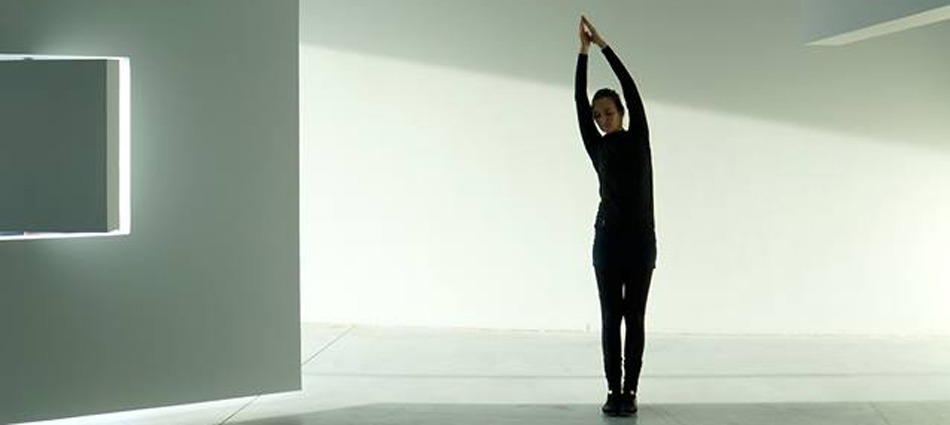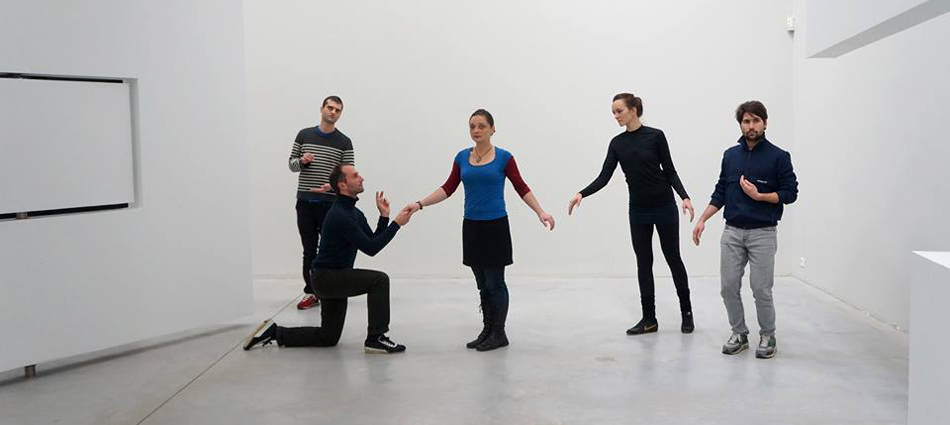For three months I was one of the performers for the An immaterial retrospective of the Venice Biennale project in 2013, when Alexandra Pirici and Manuel Pelmuș short-circuited the art world with their performance at the Romanian pavilion. These were three months of endurance, physical strain, but of praise as well and reinforcing my confidence in my own artistic forces.
It’s been almost a year since the two artists found out they were going to represent their country at The Venice Biennale, a decision that was about to make them some of the most sought after Romanian artists. They made project after project and rumor has it that the two are so busy, they actually hired lookalikes to take their places while attending local exhibition openings.
Paul Dunca: Your recent works, the one presented at the Playground festival in Leuven, Belgium and the one at Van Abbemuseum in Eindhoven, The Netherlands, both have the same title – Public Collection – but are different in accordance to the respective context. What does this title mean (for you)?
Alexandra Pirici: The piece of work from the exhibition at Van Abbemuseum is actually called Public Collection of Modern Art and it’s a version of Public Collection made for a curatorial proposal that targets modernism and a distinct period of time (1848-1989 and up to present day). Our initial structure of Public Collection introduces an immaterial collection of art works that seem relevant to us, some famous, others less known, that can cross the history of art from the moment the museum was founded as a public institution, but also as a space of archive, historicization and reflection. We are interested in the idea of a “collection” as a fundamental element of the “museum” concept and want to introduce an intangible version for a future museum.
Manuel Pelmuș: This work sees the museum as a historical construct. The museum has only been recently invented. It is a modern invention, and the moment when collections have become public and accessible to the large public, was a very important moment for society indeed. Our work talks about the possibility of an immaterial collection. The museum was and still is a place where tangible objects are collected and circulated. This type of museum is actually a representative for the society that build it, an industrial society that produces a lot of things. We put forward the idea of immaterial collections containing objects that exist only when they materialize in our actions.
Paul Dunca: Tell me a little bit more about the selection process for the works that have been enacted for the two projects.
Alexandra Pirici: We chose works of art that we like and that we find relevant. It is, of course, a subjective selection that is not and could not possibly be comprehensive. For Public Collection of Modern Art for example, we chose a lot of manifestos – we felt that its format better contemplates a certain need in an age where one suggests a direction and one precisely choose whether he’s for or against something – from the Communist Manifesto to Donna Haraway’s A Cyborg Manifesto and Accelerate – A Manifesto for Accelerationist Politics written in 2013.
Manuel Pelmuș: We tried to include works of art that are important for the history of art or for history in general. But we also chose less known works that we considered important or wanted to bring in the spotlight. We also wanted to mix different mediums, from traditional formats like painting and sculpture, to installations and conceptual works or video art. In the Van Abbe project, there was a very well defined curatorial program that addressed the modern era and modernism, so our response was selecting a lot of works made in 1848-1989 which, in our opinion, reflected the promises and contradictions of the modernist project.
Paul Dunca: Your practice gives me a strong feeling of empowerment. It makes me feel like I, myself could reenact famous works of art from the world’s museums by simply being the possessor of my body. What does the human body mean for you at this time?
Alexandra Pirici: The process of “rescaling” is very important in deconstructing the monumental and measuring it using the human body. It is not a man-centered step, it’s more of an intention to build another kind of aesthetics, to invest in the reality of human presence and to leave the original reference and its “aura” in the background. I consider the human body to be an intelligent material and I am interested in how it can produce an ambiguous relationship between subject and object and how it can function somewhere between subject and object.
Manuel Pelmuș: You’re right. The fact that we use a few bodies to transform the works of the biggest museums in the world does give a feeling of empowerment, just like you said, but in the sense that you are reclaiming history. You bring everything in the present but the relationship with history gets tensed. It is an aesthetic gesture, but it is also a very political one.
Paul Dunca: Let’s say we’re in the year 2053 and that in most fields of work, robots have replaced humans. Would you consider replacing the performers in your works with androids? Why?
Alexandra Pirici: This is an interesting question that recently came up in a discussion about how the museum could buy one of our works and how it would function in the future. I am tempted to say “yes”, but the decision depends on the situation: the android’s role in society is an important factor, whether it would perform subordinated to human society or whether it would have its own autonomy, like A. I. I’d be more interested in the latter, were machines (or some machines) are autonomous, part of nature-culture and have equal statute. In this case I think it would be interesting to reactivate the project with cyborgs or androids.
Manuel Pelmuș: We’ve been asked this question recently. If our piece were to be purchased, how much control can one have over it and over the way it will be presented in the far future, especially in our case where the work only exists when it is materialized by the bodies of people (still). Maybe the curator will also be a robot, hehe. I would be curious to see our work in a post-human future, but there are too many variables to take into account at this time and I might give an answer that is over-simple.
Paul Dunca: What are your professional plans for the future? Are you considering the Romanian artistic space?
Alexandra Pirici: Yes, we have plans for the Romanian artistic space too. We are working on a lot of projects at the moment, together and on our own as well. We are exhibiting Public Collection in a few other museums and I continue to work in the public space – a new piece would be an immaterial monument commissioned by the Public Art Agency in Sweden.
Manuel Pelmuș: There will always be a project in Romania. We will present Public Collection in a few other museums in 2015 and we will begin working new projects that are also tied to our current preoccupations and our recent works.
POSTED BY
Paul Dunca
Paul Dunca - a physical queer activist - was born in 1983 in Bucharest where he still lives and works today. After graduating the National University of Drama and Film “I.L.Caragiale” (Choreograph...





Comments are closed here.